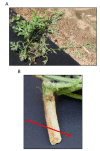Fusarium oxysporum f. sp. niveum Molecular Diagnostics Past, Present and Future
- PMID: 34575897
- PMCID: PMC8468614
- DOI: 10.3390/ijms22189735
Fusarium oxysporum f. sp. niveum Molecular Diagnostics Past, Present and Future
Abstract
Watermelon is an important commercial crop in the Southeastern United States and around the world. However, production is significantly limited by biotic factors including fusarium wilt caused by the hemibiotrophic fungus Fusarium oxysporum forma specialis niveum (Fon). Unfortunately, this disease has increased significantly in its presence over the last several decades as races have emerged which can overcome the available commercial resistance. Management strategies include rotation, improved crop resistance, and chemical control, but early and accurate diagnostics are required for appropriate management. Accurate diagnostics require molecular and genomic strategies due to the near identical genomic sequences of the various races. Bioassays exist for evaluating both the pathogenicity and virulence of an isolate but are limited by the time and resources required. Molecular strategies are still imperfect but greatly reduce the time to complete the diagnosis. This article presents the current state of the research surrounding races, both how races have been detected and diagnosed in the past and future prospects for improving the system of differentiation. Additionally, the available Fon genomes were analyzed using a strategy previously described in separate formae speciales avirulence gene association studies in Fusarium oxysporum races.
Keywords: Fusarium oxysporum f. sp. niveum; comparative genomics; diagnostics; distribution; effector profile; fusarium wilt of watermelon; race differentiation.
Conflict of interest statement
The authors declare no conflict of interest.
Figures





Similar articles
-
Marker Development for Differentiation of Fusarium Oxysporum f. sp. Niveum Race 3 from Races 1 and 2.Int J Mol Sci. 2021 Jan 15;22(2):822. doi: 10.3390/ijms22020822. Int J Mol Sci. 2021. PMID: 33467563 Free PMC article.
-
Use of Comparative Genomics-Based Markers for Discrimination of Host Specificity in Fusarium oxysporum.Appl Environ Microbiol. 2017 Dec 15;84(1):e01868-17. doi: 10.1128/AEM.01868-17. Print 2018 Jan 1. Appl Environ Microbiol. 2017. PMID: 29030446 Free PMC article.
-
First Report of Fusarium oxysporum f. sp. niveum Race 2 as Causal Agent of Fusarium Wilt of Watermelon in Indiana.Plant Dis. 2005 Jan;89(1):108. doi: 10.1094/PD-89-0108A. Plant Dis. 2005. PMID: 30795300
-
Current Status of Fusarium oxysporum Formae Speciales and Races.Phytopathology. 2019 Apr;109(4):512-530. doi: 10.1094/PHYTO-08-18-0320-RVW. Epub 2019 Mar 4. Phytopathology. 2019. PMID: 30461350 Review.
-
Deciphering Pathogenicity of Fusarium oxysporum From a Phylogenomics Perspective.Adv Genet. 2017;100:179-209. doi: 10.1016/bs.adgen.2017.09.010. Epub 2017 Oct 31. Adv Genet. 2017. PMID: 29153400 Review.
Cited by
-
Functional analysis of root-preferential oil palm metallothionein promoter in tobacco.Transgenic Res. 2024 Oct;33(5):383-397. doi: 10.1007/s11248-024-00396-8. Epub 2024 Aug 9. Transgenic Res. 2024. PMID: 39120800
-
The Improved Biocontrol Agent, F1-35, Protects Watermelon against Fusarium Wilt by Triggering Jasmonic Acid and Ethylene Pathways.Microorganisms. 2022 Aug 25;10(9):1710. doi: 10.3390/microorganisms10091710. Microorganisms. 2022. PMID: 36144312 Free PMC article.
-
Mycoviral Diversity of Fusarium oxysporum f. sp. niveum in Three Major Watermelon-Production Areas in China.Microorganisms. 2025 Apr 14;13(4):906. doi: 10.3390/microorganisms13040906. Microorganisms. 2025. PMID: 40284742 Free PMC article.
-
Acute lymphoblastic leukemia with Fusarium solani infection: a case report.Front Med (Lausanne). 2025 Aug 1;12:1561843. doi: 10.3389/fmed.2025.1561843. eCollection 2025. Front Med (Lausanne). 2025. PMID: 40823577 Free PMC article.
-
Pathogenicity Differentiation of Fusarium spp. Causing Fusarium Basal Rot and Wilt Disease in Allium spp.Pathogens. 2024 Jul 16;13(7):591. doi: 10.3390/pathogens13070591. Pathogens. 2024. PMID: 39057818 Free PMC article.
References
Publication types
MeSH terms
LinkOut - more resources
Full Text Sources
Miscellaneous

